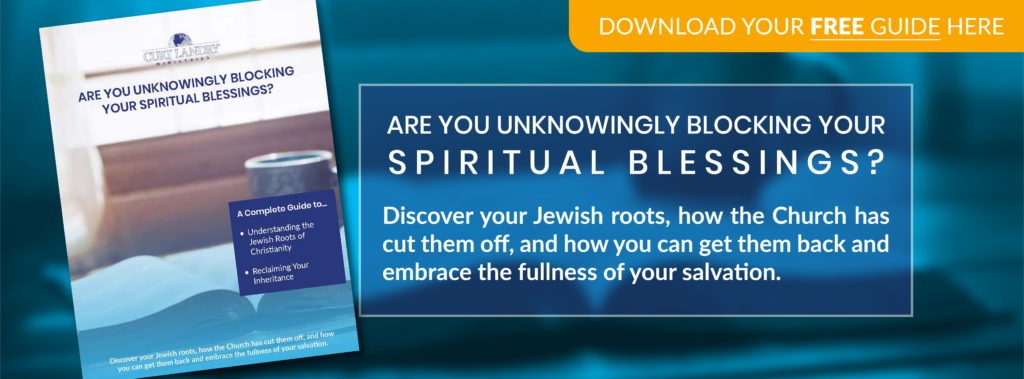The Jewish Roots of the Christian Church – Part 1 | What They Are, How They Were Removed, and How This Impacts Us Today
At the root of the Christian Church is Judaism and the relationship between the God of Abraham, Isaac, and Jacob, and His people.
The History of the Israelites in the Bible
The Jews, or Israelites, were separated out from all other people on earth to be God’s representatives among every tribe and nation.
But why?
Let’s go back a few more generations to Noah…
“Then the Lord saw that the wickedness of man was great in the earth, and that every intent of the thoughts of his heart was only evil continually.”—Genesis 6:5
It grieved the Lord’s heart to see wickedness rule in the creation He made to be His image bearers. He would not allow sin to rule and take over humanity. He had a plan—which holds true forever—to bring salvation from a simple, humble, and obedient people—the Israelites.
However, even after the flood, humanity still struggled with pride and selfishness. The Tower of Babel was built and once again, the Lord wanted to realign His creation with what was right and pure. So, He chose a faithful man, Abram, who He knew was obedient and concerned about living an example of faith that would teach his children the Lord’s commandments.
The Lord gave Abram instruction, and he faithfully followed.
Now the Lord had said to Abram…
Get out of your country, from your family and from your father’s house, to a land that I will show you. I will make you a great nation; I will bless you and make your name great; and you shall be a blessing. I will bless those who bless you, and I will curse him who curses you; and in you all the families of the earth shall be blessed.”—Genesis 12:1-3
The Lord just set the stage for the rest of eternity. His desire still remains to bless the nation of Israel and those who align with her.
Because Abram, who became Abraham, was credited as righteous because of his faith, the Lord set him apart to show the world the good, sovereign, and just characteristics of Himself. Abraham means the father of many nations.
In Summary:
God used Abraham, the first person ever to be referred to as a “Hebrew,” and his family—known later as the Israelites and the Jewish nation—to save humanity. He was chosen and blessed by the God of the Universe to be a lifeline to the world. It was by Abraham’s faith that he was chosen (see Genesis 15:1-6).
God’s Promises to Abraham and His Family
God promised Abraham land…
- “Now the Lord had said to Abram: ‘Get out of your country, from your family and from your father’s house, to a land that I will show you.’”—Genesis 12:1
God promised Abraham a great name and nation…
- “I will make you a great nation; I will bless you and make your name great; and you shall be a blessing.”—Genesis 12:2
God promised Abraham that through him all the earth would be blessed…
- “I will bless those who bless you, and I will curse him who curses you; and in you all the families of the earth shall be blessed.”—Genesis12:3
Abraham likely had no idea how major this blessing was. His descendant would be God the Son—the Savior and Messiah—who would bring together Jew and Gentile under God the Father, and graft them together as His family.
How Did the Christian Church Start?
One could say the root was planted in Genesis and brought together at the cross. The biblical Christian Church was created by Jesus, who was born a Jew. His followers were both Jew and Gentile. Most of the New Testament was written by Jews, with the exception of Luke.
The Apostle Paul—a descendant of Abraham, from the tribe of Benjamin, and a Pharisee—wrote nearly half of the 27 New Testament books alone. The Gospels (the first four books of the New Testament), which the Christian Church was founded on, addressed a Jewish audience, and the New Testament was written within the structure of Jewish culture and tradition.
As Jesus began His mission of proclaiming the Kingdom of God, healing the sick, caring for the poor, and revealing the heart of the Father, He was rejected by many of His people but was adopted by both Jew and Gentile followers who were rooted in Judaism. Therefore, the early Church was simply considered a “Jewish sect.”
From Judeo-Christianity to a Hellenistic Culture
Sadly, over time, as the gospel spread, Christianity became increasingly more Roman than Jewish. If you read the biblical text through the lens of…
- The time period it was written
- To whom it was written
- The authors themselves
… you see the richness of the heritage it holds for all of those who are in Christ.
The 1st century Church had a Jewish core with Gentiles grafted in. Then, a Roman influence began to penetrate the roots.
The Romans first occupied Israel in 63 BC. The Church still thrived as two of its pillars—Peter and Paul—continued to teach and lead other followers to spread the news of Christ the Messiah.
Even though Believers were persecuted, the Church grew. However, so did the Roman empire.

The Death of Peter and Paul
After the Second Temple was destroyed and the Jews were exiled from Jerusalem, the Church shifted from Jerusalem to Rome. This was a gradual and unconscious shift—resulting in a loss of identity and a gain of man’s traditions.
Just before the temple was destroyed, Paul and Peter died in 66 AD. Then came the destruction of the temple, and by the 2nd century, something we now call “replacement theology” began to take place.
When and Who Destroyed the Second Temple?
The Second Temple had stood in Jerusalem for 420 years before its destruction in 70 AD. Prior to its destruction, the Jewish people—who were subject to the Roman empire—had become tired of the oppression and pagan beliefs that had continued to press in and defile what was sacred. They led a revolt (later known as the First Jewish-Roman War), and fully occupied Jerusalem in 66 AD.
Then in 70 A.D. the Romans captured Jerusalem and destroyed the Second Temple with only a portion of the Western Wall left. This section of the wall still remains today and is a sacred site for many.
So, with this Part 1 of “The Jewish Roots of the Christian Church,” we see a very brief history of the early Church. Next, we will begin to unpack more about the definition of “replacement theology” and how it came to be. Then ultimately, what has been the outcome and how it ihttps://curtlandry.com/jewish-roots-of-the-christian-church-what-is-the-good-news-of-the-gospel/mpacts you—and the Church—today.
